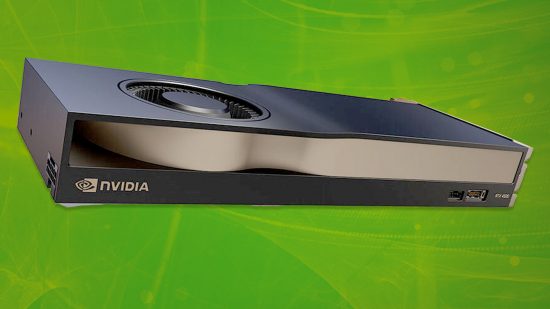Nvidia has just announced three new graphics cards, the RTX 5000, RTX 4500, and RTX 4000, but these aren’t next-gen gaming GPUs – they’re new Nvidia workstation graphics cards. Quite why Nvidia has chosen to provide such confusing and contradictory names for its workstation cards is anyone’s guess, but these new models all use the familiar Ada architecture that sits at the heart of the company’s RTX 4000 family of gaming GPUs.
While it’s disappointing that these aren’t the RTX 5000 cards we were looking for, they do bring a host of big upgrades for workstation users.
Top among the new cards is the RTX 5000, which uses the same AD102 GPU as in the RTX 4090. However, it only houses 12,800 CUDA cores compared to the 4090’s 16,384 CUDA cores and is positioned just below the existing flagship RTX 6000 which has 18,176 CUDA cores.
The RTX 5000 includes 32GB of memory, compared to the RTX 6000’s monstrous 48GB of memory. It’s rated to a relatively modest 250W TDP, though, showing how these cards are optimized for sustained rather than peak performance. The RTX 5000 price is $4,000.
Next in the lineup is the RTX A4500, which uses the AD104 GPU of the RTX 4070 but is equipped with 7,680 CUDA cores rather than the gaming card’s 5,888. The A4500 also includes a massive 24GB of memory. It’s rated to 210W TDP and the RTX A4500 price is $2,250.
Finally, there’s the RTX 4000, which was previously released in a small form factor (SFF) design but is now available in a low-profile, single-slot design. Its power rating has also increased from 70W to 130W, with the boost clock increasing from 1.56GHz to 2.2GHz. The RTX 4000 price is $1,250.
All the new cards support a full 16x PCIe 4 interface, rather than the cut-down 8x interfaces we’ve seen on some lower-end Nvidia gaming GPUs, and will feature a quad DisplayPort 1.4a configuration, with no HDMI ports. The RTX 4000 has one mini-DisplayPort, but all the other models have a full complement of full-sized connectors.

This Nvidia workstation graphics card release follows shortly after AMD released its own much more modestly-priced workstation graphics cards. Its AMD Radeon Pro W7600 and W7500 cards are aimed at entry-level workstations with card prices of $646 and $429 respectively. These two models take on Nvidia’s own entry-level models, the T1000 and A2000.
While these new Nvidia cards won’t be making it onto our best graphics card list – as we only test gaming GPUs – you can find our latest AMD and Nvidia graphics card recommendations there.
Do you use a workstation with a high-end graphics card? And will these new Nvidia cards make for a meaningful upgrade for you? Let us know your thoughts on the Custom PC Facebook page, via Twitter, or join our Custom PC and Gaming Setup Facebook group and tap into the knowledge of our 400,000+ members.
